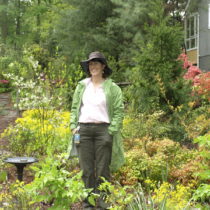Landscape Architecture for Landscape Architects › Forums › PLANTS & HORTICULTURE › Pervious Parking: What Type of Plant to Use?
- This topic has 1 reply, 11 voices, and was last updated 12 years, 7 months ago by
 Andrew Garulay, RLA.
Andrew Garulay, RLA.
-
AuthorPosts
-
December 26, 2012 at 11:12 pm #155860
mark foster
ParticipantFrom a growing media perspective, I have found the plastic pavers (i.e. “grass pave”) perform better than the concrete ones. Some of this may be due to the lime leaching out of the concrete (especially at first). It also seems that the concrete pavers cause the medium to dry out more quickly–probably acting like a wick.
The only drawback to plastic is it is sometimes too successful–the grass completely grows over the grid and makes it indistinguishable from lawn. We usually line the edges of the parking to delineate it if we suspect this to be the case.
A year ago, we installed a “light use” grass parking area (used for once every month or two) using nothing more than 50% topsoil/50% rounded river stone (1″-2 1/2 diameter) in a 6″ lift on native soil. So far, this has been very successful, but it may be too early to declare complete victory, and will probably only work in clay soils which have good compaction/bearing capacities.
Also, if you choose a paver, take the specs with a grain of salt– If you follow the entire profile (rock, sand, soil cloth, sand/soil mix), it may be able to sustain a fire engine, but it turns the growing medium into something more akin to a golf course green– which requires much irrigation.
December 27, 2012 at 4:56 pm #155859 Jordan LockmanParticipant
Jordan LockmanParticipantI am in Minnesota so I do not know specific plants for Atlanta. Generally Moss is not a terrible idea if it grows naturally. I always try to work with what the site gives me instead of forcing my design to fit the conditions. So if the site gives you shade with moisture maybe moss is great. If the site is more open to sun, there are grasses that work great in little used areas with grass pave or the like.
December 30, 2012 at 11:34 pm #155858 BoilerplaterParticipant
BoilerplaterParticipantThe use of synthetic turf isn’t a bad one. Its hard to get much of anything to grow around those planatable blocks in hot climates because the blocks retain the sun’s heat and the soil just gets baked. When I was in Las Vegas, we used synthetic turf between pavers. Hotlanta gets almost as hot, but of course its a wetter climate. In your case it is apparently wet and shady enough to support moss, so you could take steps to improve the conditions for moss with misters and soil acidifiers.
December 31, 2012 at 11:51 am #155857 Andrew Garulay, RLAParticipant
Andrew Garulay, RLAParticipantA great concept and philosophy at some point is affected by situational reality.It sounds easy until you actually have to do it. Then you find out why tings get built the way they do.
January 1, 2013 at 8:24 pm #155856 Ann EnglishParticipant
Ann EnglishParticipantHi JA –
If you want a pervious surface, first figure out if the water, once it is through the surface, will be soaking in or flowing along just under the surface — you can look at this website to see how permeable pavement bases typically work: http://ncsu.edu/picp/. Since you will be parking over the space for long periods of time, using a PICP type approach (ie non-vegetated but pervious) makes the most sense. You could design the base per PICP and then modify the materials for the top, making sure you have spaces between your pavers and filling between the pavers with washed # 8 or # 9 stone. The lack of fines is critical. You should do a perktest too to deterimine if it can actually soak into the surrounding (clay) soil or if you need to have an underdrain to let the water out after it has been filtered by the pavement system. I would suggest that you check out Bruce Ferguson’s book on permeable pavements too.
Moss indicates a compacted acidic site (not too surprising in Atlanta).
-
AuthorPosts
- You must be logged in to reply to this topic.


